
Report of the Joint Legislative Commission on Governmental Operations
House Majority Staff
July 2025
Key points
- Lack of leadership: NCORR’s failures start with a lack of involvement, leadership, and accountability in the Governor’s Office.
- Risk aversion: NCORR designed its rules and processes to not risk having the federal government reclaim spent money, which led to local permitting problems, supply delays, and higher costs for individual homes.
- Mission creep: NCORR took on or was given tasks unrelated to the core mission of getting people home—from emergency rental assistance during the pandemic to resiliency planning for communities and upgrading the condition, energy efficiency, and storm resiliency of each new or rehabilitated home.
- Bad budgeting: NCORR failed to budget correctly, so pledged $209 million to affordable housing projects, buyouts of the most flood-prone homes, and community resiliency policy reports. Only in August 2024 did NCORR discover it needed more than $300 million to complete promised renovation and reconstruction projects for 1,759 unfinished homes.
- Far-reaching impact: The result has been universal frustration. Homeowners have lived in hotels or damaged homes for years waiting for work to be completed. Some of them will still not have work completed before NCORR closes shop in early 2026. The General Assembly provided $297 million between October 2024 and March 2025 amid pressing needs from Hurricane Helene’s devastation in western North Carolina.
Introduction
The North Carolina Office of Recovery and Resiliency (NCORR) was created to help repair or replace homes damaged by Hurricane Matthew in 2016 or Hurricane Florence in 2018. Lack of leadership and accountability, starting with Gov. Roy Cooper’s inattention, undermined good intentions. Applicants progressed in the program without a clear path to recovery. Director Laura Hogshead’s stated desire to ensure North Carolina did not risk having to repay funds by running afoul of federal rules led to the agency making promises it could not keep while failing on its fundamental duties.
Failing on fundamentals
Lack of leadership and accountability
GOVERNOR’S OFFICE: Gov. Cooper deliberately kept himself out of the process. For example, Hogshead could not provide examples of Cooper asking questions or otherwise engaging in meetings. On the crucial question of accepting applications until April 27, 2023, more than 4½ years after Hurricane Florence and 6½ years after Hurricane Matthew, Hogshead testified only that “someone in the Governor’s Office” demanded the extension. NCORR received 767 new applicants in the final three months between January 26 and April 27.
DEPARTMENT OF PUBLIC SAFETY: Secretary of Public Safety Erik Hooks also kept his distance. Hogshead worked with Emergency Management Director Mike Sprayberry, then with DPS Chief of Staff Jane Gilchrist, but Hooks had almost no involvement with NCORR. After Sprayberry left, nobody at DPS held NCORR accountable, assisted in its mission, or provided administrative support.
Without Sprayberry, Hogshead alienated colleagues in state government, including Stephanie McGarrah, who is now in charge of housing recovery in western North Carolina.
RENTAL ASSISTANCE: NCORR’s role expanded to include Emergency Rental Assistance through the first federal Covid package in 2020 and the American Rescue Plan Act in 2021 (ARPA). The amount of money in these two programs and the speed with which they needed to be completed distracted NCORR management attention from hurricane recovery, the main task for which it had been created.
SLOW COMPLETIONS: Between November 2021 and August 2022, NCORR completed fewer than ten houses per month. The Gov Ops Subcommittee on Hurricane Response and Recovery first met in September 2022, after which the pace of completions accelerated to roughly 60 per month through 2023. NCORR managed more than 100 completions per month from January 2024 through April 2025 before delays from its temporary lack of funding caught up to it.
BAD FAITH AND BAD WORK: The lack of accountability for NCORR and its lack of focus extended down to its monitoring of contractors and homeowners. NCORR awarded homes to vendors in large batches with few tools for accountability. It received more than 1,000 homeowner complaints for shoddy work including leaks, mold, electrical hazards, structural defects. There have been numerous complaints of poor workmanship, incomplete problem inspections, and acceptance of homes with unrelated damage. NCORR was hesitant to impose liquidated damages for fear of driving away contractors.
Poor process
FIRST THINGS LAST: At the start, NCORR attempted to rely on outside vendors instead of hiring a large staff. It selected Horne for project management and AECOM for construction management. NCORR restricted direct communication between the two firms, which meant important construction restraints were not discovered until homeowners were out of their homes and work was ready to start. Some families are still out of their homes due to septic system problems, local setback rules, heirship disputes, HOAs, and historic districts that likely would have been discovered and able to be resolved earlier. NCORR has warned that as many as 100 families may not be able to have work completed because of such complications, though some of them are still living in their storm-damaged homes.
HANDOFFS: Besides normal turnover in customer service positions, and especially high turnover from March 2020 through 2022, families in the NCORR system had to deal with another new case manager during the handoff between Horne and AECOM. In 2022, NCORR ended its contracts with both Horne and AECOM, eventually bringing its own staff to more than 250 people and entering a staff augmentation contract with HGA for more than 100 customer service and managerial positions. Homeowners frequently found themselves with new case managers, resulting in inaccurate or conflicting information when they were able to connect. Many felt trapped in bureaucratic limbo.
HIGH HOTEL COSTS: No other state had a similar TRA program to provide housing and storage while families were out of their homes. Emergency move-outs due to mold or other circumstances did not lead to greater observed urgency for home completion. Many families were in hotels for more than a year. As of January 31, NCORR’s most recent report on TRA expenditures, 66 projects had relocation costs in excess of $100,000. The most expensive was $278,981. NCORR eventually began paying stipends to families instead of directly paying hotels or landlords.
Numerous people also had their belongings ruined after storing them in NCORR-provided PODS that were never climate controlled and occasionally leaked.
ASSIGNMENTS: The agency asked the General Assembly, privately and in open committee, to change the law so it could assign higher value projects. Hogshead explained that the low limits prevented it from assigning many projects. Both chambers passed separate bills that indicated their support for higher assignment limits, and the clear legislative intent cleared the bureaucratic hurdles. Although NCORR did not assign many projects, the legislature’s actions removed an excuse for the agency’s lack of progress.
Missing forecasts
The final core function where NCORR failed was in forecasting its work and financials. This came to a head in October 2024 when NCORR asked the legislature for $175 million to complete the remaining 1,200 homes. By March 2025, the total amount of state funds needed had grown to $300 million even as the date for completing homes slipped from September to possibly December. Even with the additional funds, NCORR anticipates it will not be able to complete as many as 100 of the remaining projects because of permitting, ownership, or other issues.
Exceeding its mandate
“Resiliency”
STAFF: NCORR hired two people to research and recommend resiliency policies. As NCORR wound down in 2025, it tried to get those people transferred to the Department of Environmental Quality where the Flood Resiliency Blueprint is housed.
SPECIFICATIONS: NCORR added resiliency work to repair projects even in rooms reportedly undamaged by storms or flooding. The additional work led to higher costs and longer delays. It held all homes to a single standard for wind resistant siding, insulation, and windows, mandated electric appliances, and installed tankless electric water heaters. The water heaters in some cases required separate electrical installation with higher capacity, again increasing cost and time.
SIZE: Rather than matching the size and number of rooms in the original floorplan of homes, NCORR applied federal guidelines for new construction. Depending on the number of people in a home, the reconstructed property could become much smaller with fewer bedrooms or larger with more bedrooms than the home being replaced. Larger homes could exceed the capacity of the land for septic or municipal setback rules, meaning higher cost, more delays, and possibly exit from the program.
Excess customization
Although NCORR used a single standard for storm survival in homes, it offered families more than 26 floorplans, many of which it later attempted to have built as modular homes in factories but which the modular companies could not convert.
In addition to the choice of floor plans, families could initially choose among a variety of colors, appliances, and other options. NCORR did not honor all the stated preferences from families, adding to their frustrations with the program.
Conclusion
NCORR failed at basic tasks and took on more tasks than it could deliver. The result is a program that fell behind, took $300 million of state money to complete work that was supposed to be done entirely with federal grants, and still may not be able to complete all the projects in the queue. Responsibility falls not just on former NCORR Director Laura Hogshead, who resigned in December 2024, but extends to former Gov. Roy Cooper who ignored the problems through multiple legislative hearings and critical media reports.
NCORR failed at basic tasks and took on more tasks than it could deliver. The result is a program that fell behind, took $300 million of state money to complete work that was supposed to be done entirely with federal grants, and still may not be able to complete all the projects in the queue. Responsibility falls not just on former NCORR Director Laura Hogshead, who resigned in December 2024, but extends to former Gov. Roy Cooper who ignored the problems through multiple legislative hearings and critical media reports.
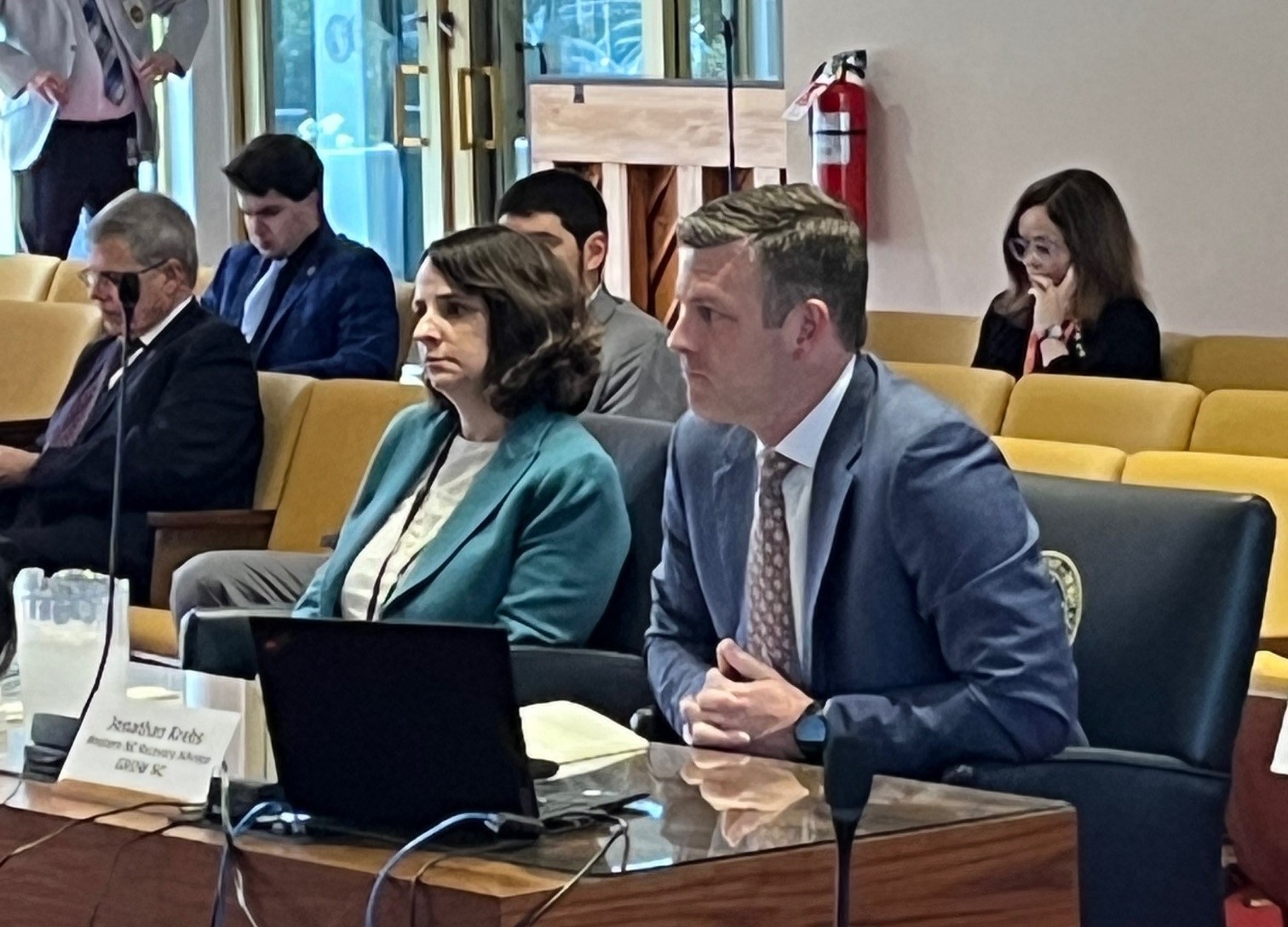
Members of the Joint Legislative Commission on Governmental Operations Subcommittee on Hurricane Response and Recovery sought reassurance that home repair and reconstruction in the western part of the state would be better run than it has been in the east.
Deputy Secretary for Community Recovery Stephanie McGarrah and Jonathan Krebs, western recovery advisor for Gov. Josh Stein, described how their proposed action plan incorporates lessons from earlier storms in North Carolina and other states.
Krebs assured members that “as long we do what we say we were going to do in that action plan, HUD will reimburse those costs at 100%.” The General Assembly had not directed any of the $1.1 billion appropriated in 2024 to housing because that answer was not clear. They were also hesitant to give any more money to the North Carolina Office of Recovery and Resiliency (NCORR), which was responsible for home repairs and reconstruction in the east.
“We’re counting on you, but more importantly, folks in the west are counting on you.”
Rep. Brenden Jones
Chairman Brenden Jones (R-Columbus) was emphatic about the failure of NCORR and the need for the GrowNC response to Helene to do better with its $1.4 billion in federal funds. He was glad to hear that McGarrah would be in Western Norh Carolina regularly and many of the staff hired by her Division of Community Revitalization would live and work in the region.
Sen. Tim Moffit (R-Polk), Sen. Steve Jarvis (R-Davidson, Davie), Rep. Karl Gillespie (R-Macon), and Rep. Mark Pless (R-Haywood) worried about higher costs from excessive local, state, and federal regulation. They insisted that people should not be forced from land that may have been in their family for generations.
Rep. Pless also expressed concern that the action plan directs $53 million to build new affordable housing and workforce housing instead of replacing or repairing homes damaged by the Helene.
In his closing comments, Krebs offered three statutory changes that could help. First, the state could offer an affidavit to help resolve properties with multiple heirs, as in Texas. Second, a Florida law provides a model to speed permits and inspections. Third would be to ensure agencies have “prepositioned contracts” with vendors to respond rapidly in an emergency.
After reminding Krebs and McGarrah that “failure is not an option,” Chairman Jones reiterated, “We’re counting on you, but more importantly, folks in the west are counting on you.”
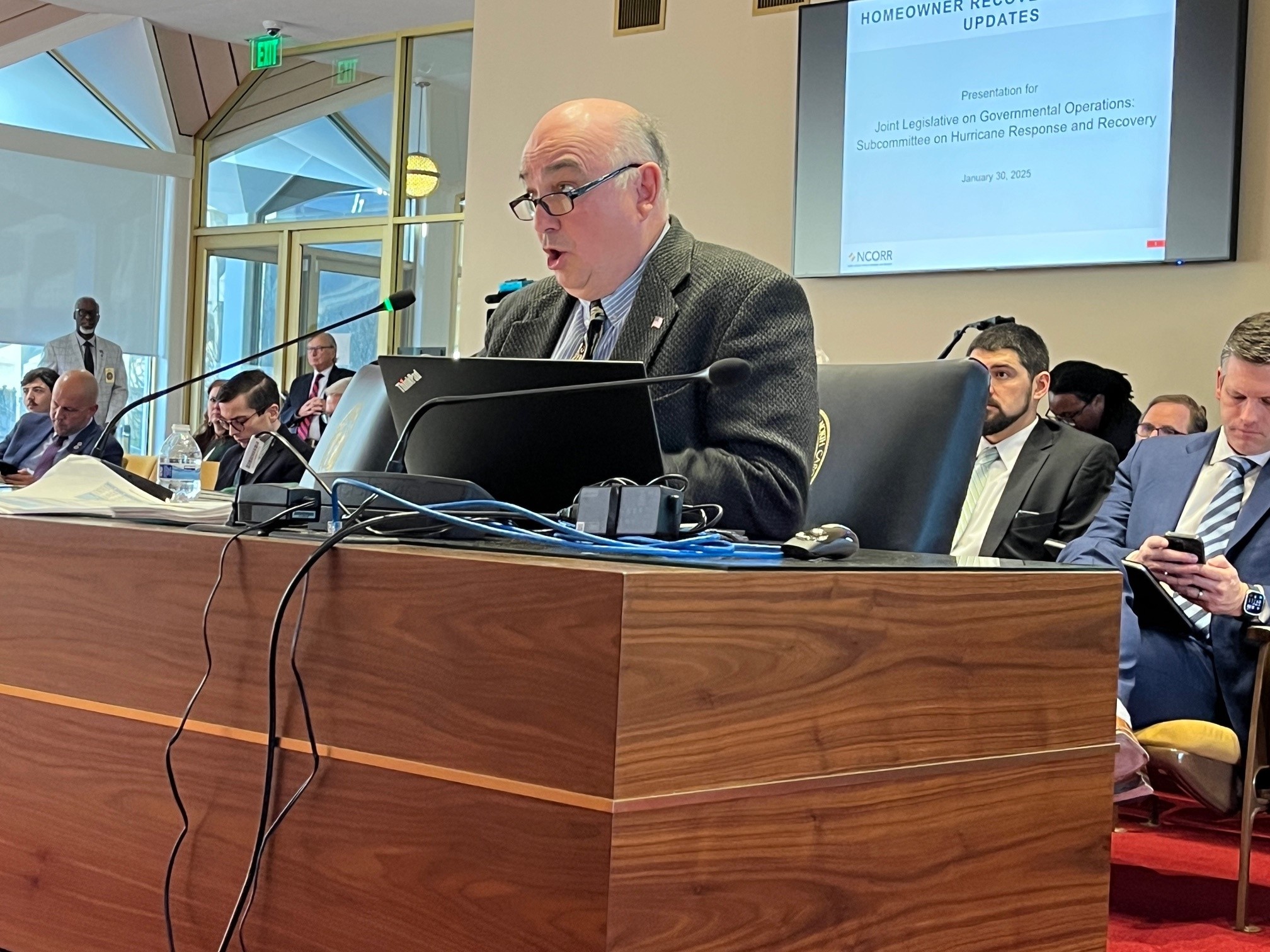
The North Carolina Office of Recovery and Resiliency (NCORR) expects it will take $220 million in additional state funds to complete work by the end of 2025 on 1,150 homes damaged by hurricanes Matthew and Florence. Another 39 homes might not be completed due to “atypical” circumstances.
NCORR Director Pryor Gibson testified before the Joint Commission on Governmental Operations Subcommittee on Hurricane Response and Recovery for nearly two and a half hours on January 30. Jonathan Krebs, advisor to Gov. Josh Stein on western North Carolina recovery, and Stephanie McGarrah, deputy secretary in the Division of Community Revitalization at the Department of Commerce, followed Gibson. They have been invited back before the committee to provide more details March 6.
The Subcommittee held its first hearing with NCORR in September 2022 when the agency was completing fewer than 10 homes per month. The federal government provided nearly $1 billion in three grants for NCORR to assist with the Eastern North Carolina storms. In October 2024, however, Gibson alerted legislators that NCORR had overcommitted funds by $175 million and would need state money to complete its work.
A more thorough accounting by the Office of State Budget and Management before the November 18, 2024, hearing showed NCORR had unmet needs of $320 million, which Gibson circuitously confirmed at the time. Legislators appropriated $30 million in November and another $50 million in December to get NCORR into February. Gibson said contractors may abandon the program without a firm commitment from the General Assembly before the end of February.
Co-chair Rep. Brenden Jones (R-Columbus) set an expectation for clear answers at the beginning of the hearing.
“No more excuses, no more delays, no more vague estimates, no more NCORR kicking the can down the road,” Rep. Jones said. “Today, as we go through this, we’re going to ask you how much money is actually needed to finish the operation. I’m going to ask you why we should believe you.”

Inconsistencies in the Gibson’s presentation over the number of employees, specific costs, and NCORR’s communication to general contractors further eroded subcommittee members’ trust and increased their frustration.
NCORR completed 143 homes in December and its latest report to Gov Ops staff showed 116 homes completed in the 30 days through January 29. In contrast, NCORR only issued 19 notices to proceed (NTPs) in that time and had not issued a contract since December 19 (see graph).
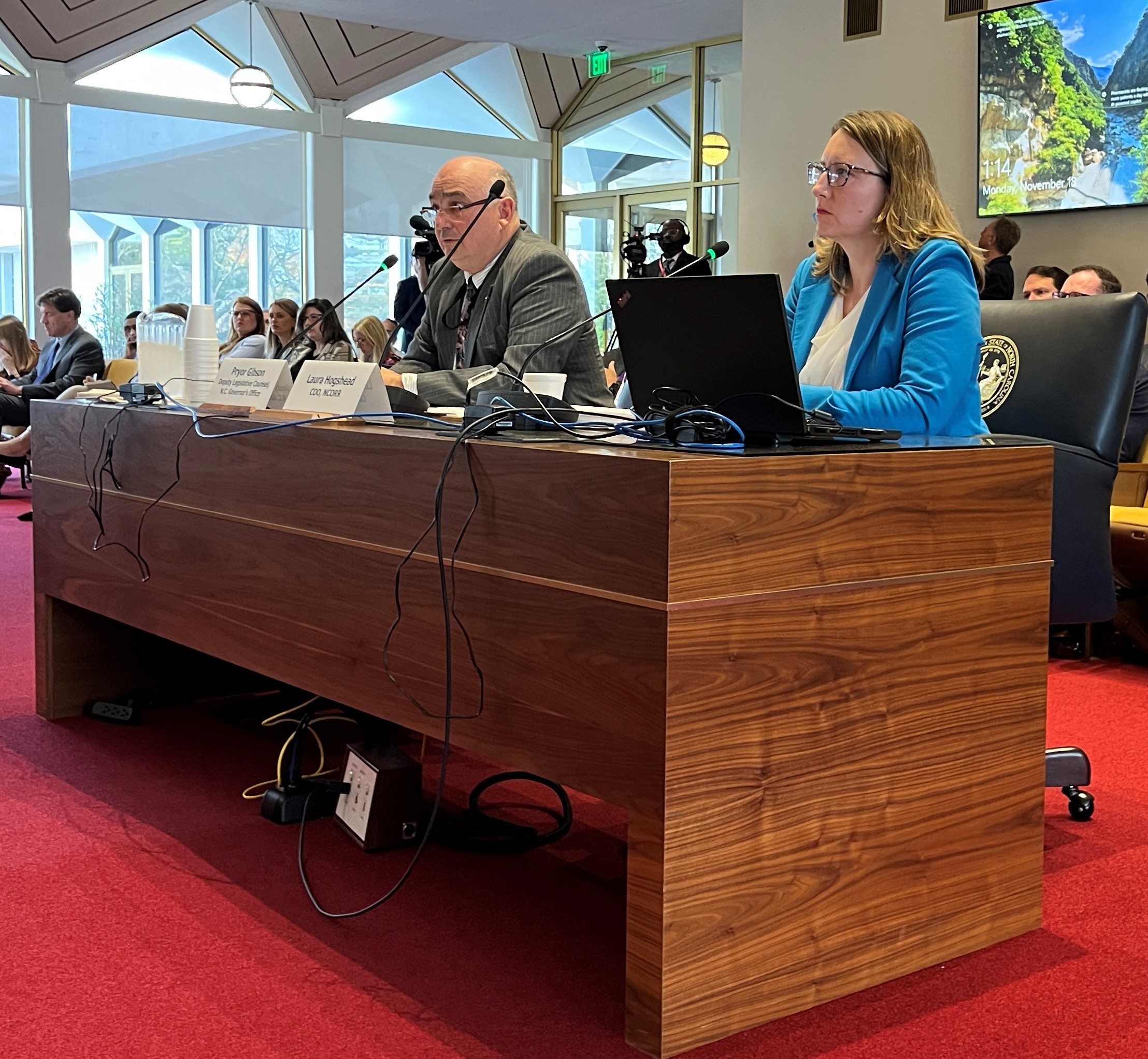
Leadership of the North Carolina Office of Recovery and Resiliency (NCORR) gave incomplete responses to pointed questions from members of the Joint Legislative Commission on Governmental Operations Subcommittee on Hurricane Response and Recovery during the November 18 hearing.
On the agency’s funding need, which her presentation and press reports inaccurately pegged at $221 million, (now former) NCORR Director Laura Hogshead said, “Worst case scenario is the $264 million number… if there’s no attrition or not able to use any other sources of funding.” But that figure did not include any contingency for higher construction costs for any of the roughly 1,400 homes still to be completed. From a spreadsheet NCORR provided to the subcommittee, building in a contingency would bring the remaining unmet need to $289 million, on top of $30 million appropriated by the General Assembly in October.
Governor Roy Cooper’s Deputy Legislative Counsel Pryor Gibson, who appeared before the subcommittee with Hogshead, first told legislative leadership about NCORR’s $289 million need on October 21, two days before the chambers were to vote on assistance to the western counties devastated by Hurricane Helene.
By 2021, NCORR budgeted $534 million of $982 million in federal funds for hurricanes Matthew and Florence to repair and rebuild homes in its Homeowner Recovery Program (HRP.) Since then, NCORR has transferred $148 million in additional funds from other purposes in that federal pot to bring the total for repairs and reconstruction to $683 million. The latest estimate for HRP is $980 million, which leaves, along with NCORR’s other spending on Matthew and Florence, a deficit of $319 million.
Hogshead acknowledged to Rep. Brenden Jones (R-Columbus, Robeson) that she did not raise flags as the program took on more than it could cover because, while staff were monitoring individual line items, no one was monitoring at the overall budget. Although she took the blame for it, Hogshead refused to resign.
While NCORR’s financial problems prompted the hearing, much of the time was spent looking back at the agency’s other problems and looking ahead to potential responses to Hurricane Helene. Gibson promised better financial reporting to the legislature, and members remained skeptical about providing more money to NCORR. Rep. Jones closed with a touching personal note about the people he and other members see every day who are counting on state government to fulfill its promises without delay.

Early intervention was top of mind for the members of the Joint Legislative Commission on Governmental Operations Subcommittee on Hurricane Response and Recovery on January 23. Legislators sought to ensure the N.C. Flood Resiliency Blueprint provides tangible results to reduce flooding and its impacts in North Carolina.
Department of Environmental Quality (DEQ) Secretary Elizabeth Biser and Project Manager Todd Kennedy were joined by Dave Canaan and John Dorman of AECOM, the contractor selected to develop the Blueprint, to testify before the subcommittee on efforts to date and the path ahead.
Of the $20 million appropriated by the General Assembly in 2021, DEQ has spent $1.9 million to produce what subcommittee Co-Chair Rep. John Bell (R-Wayne) described with disappointment as “a very, very rough draft” of a report and to develop flood mitigation strategies for the Neuse River basin. Biser provided the draft executive summary with her written testimony. The full report still faces months of revisions from staff based on input from more than 150 stakeholders and 500 comments submitted to the project team.
Another $4 million is dedicated to developing an online tool to help state and local governments prioritize flood mitigation strategies. Biser and the AECOM team said a beta version would be ready in April. The remaining $14 million would go toward applying lessons from the Neuse effort to other five other basins, including the French Broad River in western North Carolina.
“We wanted to invest time on the front end in order to make sure things went as smoothly as possible on the back end,” Biser said. This meant learning from other states, bringing in more than 150 stakeholders, and taking an agile, learning-based approach to projects and contracts instead of the traditional “waterfall” approach. For example, lessons from creating strategies and projects for the Neuse River basin will be applied to the other basins.
“We have a tendency to move at the speed of government, not the speed of business.
Rep. John Bell
We need to move at the speed of business.”
Legislators also probed Biser on the future of the Blueprint and whether it would become a permanent part of North Carolina’s government?
“I don’t want you to picture some big bureaucracy, big division-type effort,” Biser said, repeatedly iterating that she sees this as a project, not a program. Looking to future needs, Biser likened it to buying a new car and not changing its oil. “The value of the tool is directly correlated with what data is supporting it.… The data has to be maintained. If we do it one time and walk away, it’s going to be great for a few years, and then you’re going to have wasted your investment.”
Members of the subcommittee were particularly concerned about the hurdles from federal regulations and state procurement rules. Those two areas will likely be subject of further discussions, along with firmer estimates of costs for development, implementation, and maintenance.
The subcommittee will continue to monitor as each phase of the Blueprint timeline progresses and work to protect the citizens of North Carolina from catastrophic flood events and their aftermath.
“With the Blueprint, we have a tremendous opportunity in front of us,” Bell said. “Not just an opportunity to help protect lives and property and to be able to gauge how we navigate the flooding but an opportunity to show the rest of the country that we can get it right and be a model for them to use for their states. Everybody wants to get this right and have it done in a timely manner.”
Other coverage:
WRAL NC hurricane, flooding response: GOP lawmakers question top Cooper official
WUNC NC to launch $20 million data collection project to tackle future floods
CBS17 NC lawmakers question state officials about storm response
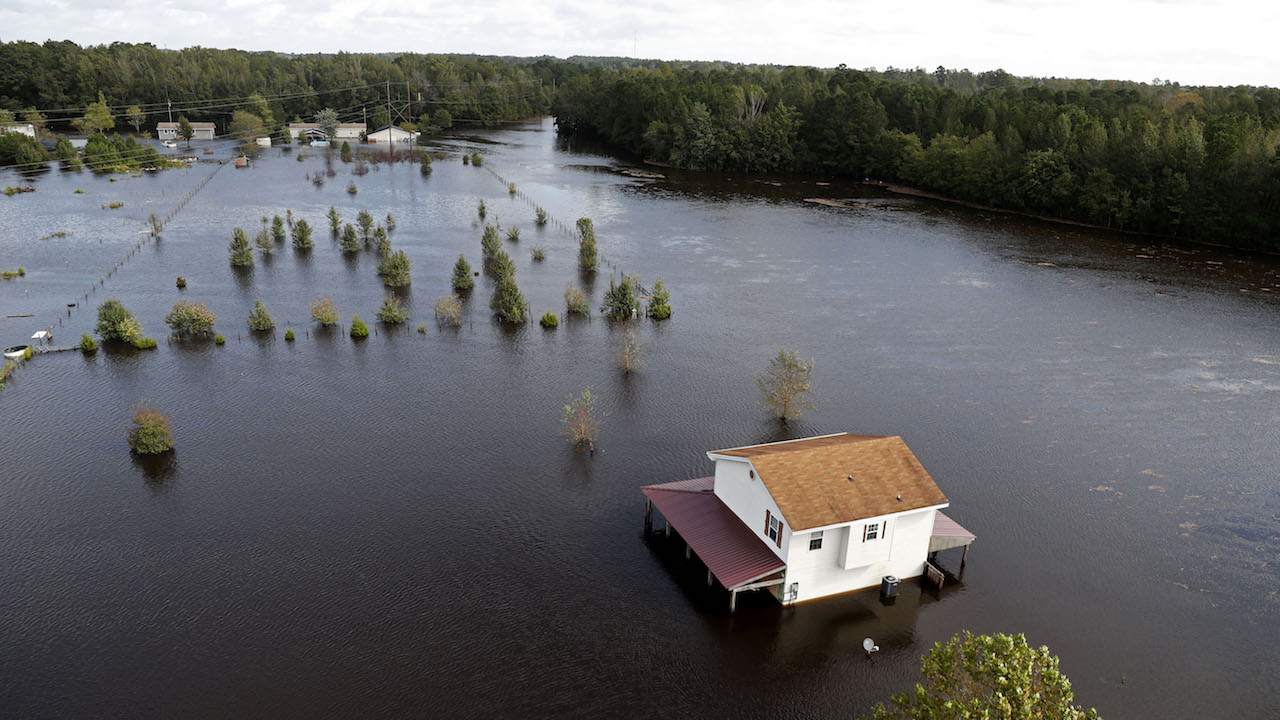
In the wake of catastrophic floods in eastern North Carolina from hurricanes Matthew and Florence and western North Carolina from Tropical Storm Fred, legislators want to reduce the devastating impact of such storms.
In the 2021 budget, the N.C. General Assembly tasked and funded the Department of Environmental Quality (DEQ) with creating the North Carolina Flood Resiliency Blueprint. The Blueprint was supposed to identify the major watersheds prone to flooding by assessing flood risk, identify data gaps, and offer recommendations to reduce flood risk for each target watershed. As part of the Blueprint, an online tool is being developed to guide decisions and strategies that reduce the likelihood and impact of flooding.
Now, the Joint Legislative Commission on Governmental Operations Subcommittee on Hurricane Response and Recovery wants concrete answers for where the Blueprint stands. DEQ Secretary Elizabeth Biser and John Dorman and Dave Canaan from AECOM, the contractor selected to produce the plan. will testify to report on how the $20 million appropriation from the legislature has been spent and what results they have to show for it. They are expected to explain how the Blueprint is fulfilling the requirements set by law passed in 2021: “A successful blueprint should ultimately lead to a prioritized set of projects and funding strategies that the State can implement.”
“Two years ago, we passed this legislation and entrusted DEQ with the responsibility to protect our citizens and mitigate the severity of major flooding,” House Majority Leader and Co-Chair John Bell (R-Wayne) “It’s time for DEQ to show what the department has done with the state’s money and its trust.”
The Joint Legislative Commission on Governmental Operations Subcommittee on Hurricane Response and Recovery will meet Tuesday, January 23 at 10 a.m.

It’s been five years since Hurricane Florence made landfall near Wrightsville Beach and sat for five days before moving inland. It was the wettest storm on record in the Carolinas, dropping 36 inches of rain in Elizabethtown alone. The storm dumped an estimated 10 trillion gallons of water in its path, turning I-40 into a river, other areas into lakes, and leaving much of the region devastated. Floodwaters continued to rise for a week or more after the storm passed. By the time it was over, Florence had claimed 42 lives and caused more than $22 billion in damage.
Worse for eastern North Carolina, Florence hit less than two years after Hurricane Matthew struck the same area. Between the initial storm surge and later downstream flooding, Matthew killed 29 people and caused $1.5 billion in damage.
Today, 3,000 residents are still waiting to have their homes repaired or replaced through the government’s Rebuild NC program. As they wait, they are living with family or friends, in hotels, or in their damaged and often mold-infested homes.
In March, Rep. Carson Smith (R-Pender) and Rep. Phil Shepard (R-Onslow) saw firsthand the living conditions of families in their districts, offering support and help in the lengthy process.
Six months later, has anything changed for those homeowners?

Marcy Bea and her family were living in a mobile home with holes in the floor and walls and prevalent mold. Since an emergency move-out in March, they have been in a hotel. Bea said things are “progressing.” The contractors demolished her old mobile home, staked the front and back porches, had supplies ready to go, and were waiting on permits.
“The supplies are all there, so I have no complaints,’ Bea said.
However, while the contractors were waiting on permits, thieves stole the bricks for the foundation. A neighbor’s camera caught the theft, authorities were notified, and the contractors have ordered replacement materials. This has not caused a delay in construction.
Willie and Carolyn Northern were still living in their home in March, despite its damaged floors and mold. They moved out in June and have been staying at a hotel in Wilmington, adding 30 minutes each way to Carolyn’s daily commute. Work has begun on their home—the carpet has been removed, and the ceiling has been painted, so there should be an end in sight.
Alverda Holmes’ home also has mold, floor damage, and roof leaks. She said the process is “moving.” The contractor has completed the pre-construction walk-through. She and her husband can begin moving out once the contractor receives the notice-to-proceed and temporary storage PODS arrive.
Holmes and her husband are using a new program that allows homeowners to accept a stipend toward rent while their homes are under construction, instead of Rebuild NC paying hotels directly. Rebuild has not documented their payment process, so Holmes is finding landlords are hesitant to rent. Without documentation from Rebuild, she cannot establish sufficient income beyond her husband’s disability payments. Rebuild staff are working on a temporary solution until the program is officially implemented.
In the year since our first hearing, however,
Rep. John Bell
Rebuild has made faster progress but not fast enough.
Robert Sault’s peaceful, remote home along the Northeast Cape Fear River flooded above the windows after Hurricane Florence. The inside of his home was unlivable. The easy-going retiree lived on his screened-in back porch before Rebuild granted an emergency move out and he moved to a hotel in January 2022. Delays at the modular home manufacturer held up progress. His home was demolished earlier this year, but a change in leadership at the county level, changes in county construction rules, and an additional environmental study caused further delays. Construction cannot begin until the study is complete.
Sault has kept a positive attitude about the long road but is ready to be back home. “If I had known it would take this long,” he joked, “I would have bought a houseboat.”
Sonya Black and her family were living in an RV behind their home waiting for repairs to begin. Since the visit in March, the family received TRA benefits from Rebuild NC and is living in a hotel. Work is slowly progressing on their home. The contractors are working on the kitchen and flooring.
“The work has been slow but sure,” Black said.
However, Hurricane Idalia didn’t leave the Blacks’ home unscathed. Their basement flooded with 3 to 4 feet of water. “We were able to put another sump pump down in there,” she said. “It took us 12 hours to drain the basement!”
Five Years Later
Everyone wants every homeowner to be home as soon as possible. Rebuild NC has been completing an average of 55 homes per month this summer but must finish more than 90 each month to beat the federal fund deadline of August 2026. Since September 14, 2022, the Joint Legislative Commission on Governmental Operations Hurricane Response and Recovery Subcommittee has been assisting homeowners and addressing accountability.
“It is unacceptable that five years after Florence, and nearly seven years after Matthew, our neighbors are still suffering. Governor Cooper stood by for years while the pace of work nearly came to a halt,” said subcommittee co-chair Rep. John Bell (R-Wayne). “In the year since our first hearing, however, Rebuild has made faster progress but not fast enough. The legislature is holding Rebuild accountable and clearing unnecessary roadblocks so they can continue to accelerate.”
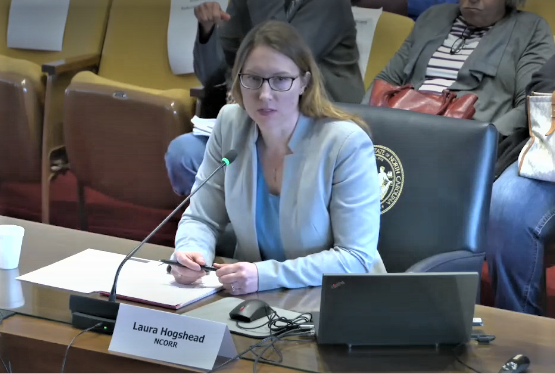
March 29, 2023
“Things can be bad, and getting better,” wrote Hans Rosling. The Swedish physician became a TED Talks staple with his vivid presentations of how the world is not as bad as we think, even if it is not as good as we would like.
Something of that came through in the March 29 hearing of the Joint Legislative Commission on Governmental Operations Subcommittee on Hurricane Response and Recovery. Laura Hogshead, who manages the Rebuild NC program as director of the North Carolina Office of Recovery and Resiliency (NCORR), testified. She was followed by Richard Trumper, newly appointed senior advisor for disaster recovery at the Department of Public Safety. The subcommittee was established in 2022 to oversee assistance to homeowners affected by Hurricane Matthew in 2016 and Hurricane Florence in 2018.
Hogshead echoed Rosling in her testimony. “We have made progress, but we are not satisfied with that progress,” she said. “We will continue to improve wherever we can.”
Bad
Although the agency has completed 278 projects since the subcommittee’s first hearing in September 2022, just about everyone involved has been frustrated with the inefficiencies, complicated rules, and communication breakdowns that have marked the Rebuild NC effort. Although NCORR and counties have completed projects for 1,067 families, the program still had 3,399 homes in in process, with many more families likely to enroll before the program stops taking applications April 21. The pace of completions has accelerated, but it would take five years to complete the remaining projects at the rate of 57 homes per month; at 40 per month, it would take another eight years to complete all the projects.
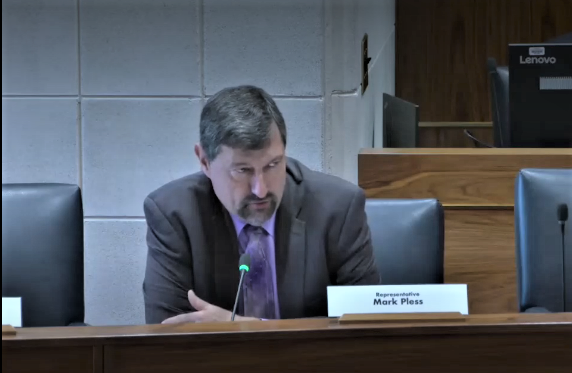
NCORR received nearly $1 billion for hurricane recovery, including $250 million set aside for other programs. The agency has spent or obligated $430 million to repair and replace homes, including $20 million on temporary relocation assistance, and $285 million on other programs. It has until August 2026 to complete its work or forfeit the remainder of the Community Development Block Grant for Disaster Recovery (CDBG-DR) and Community Development Block Grant for Mitigation (CDBG-MIT) it received.
Hogshead has cited permitting issues with local governments and weather delays. Legislators challenged Hogshead’s assertions based on their site visits and communication with local officials.
Sen. Steve Jarvis (R-Davidson, Davie) told Hogshead, “It’s disingenuous to blame counties for delays in permits when other contractors in the private sector have it figured out, and they can navigate the system.”
“Part of the problem and the reason we’re here today is government bureaucracy.”
Rep. John Bell
Hogshead acknowledged that contractors have been unprepared at times and that NCORR had not offered them much guidance. She said that NCORR’s hands-off approach was recommended by SBP’s J.R. Sanderson to let contractors deal with contractor problems and that it is the contractor’s responsibility to know how to perform the roles that they were contracted to do. Hogshead added that NCORR has advised contractors to hire employees dedicated solely to handling permits. Some counties and cities do not know which projects are Rebuild NC homes, receive incomplete applications, and find sites unprepared for inspections. What has come through most clearly is an incomplete flow of information.
But better
During the December 2022 hearing, Hogshead noted that DPS’s 30-day wait time to pay vendors (which she said was a broader state policy) led contractors to withdraw from the program because they could not pay employees or meet expenses with the delay. DPS leadership then allowed NCORR to pay bills in as little as two weeks. Contractors appreciate the faster payment schedule and NCORR will soon be able to pay with bank transfers instead of checks.
Hogshead expressed thanks for House Bill 119, currently in the Senate, which would allow NCORR to assign projects up to $250,000 to contractors, consistent with a recommendation from disaster recovery consultants at SBP. She also highlighted changes in case management and volunteer organization assistance.
NCORR has begun to impose “liquidated damage” penalties for contractor delays and reworked its contractor scorecard so that strong performers receive more work. In December, Hogshead said her office had been constrained in its ability to enforce contracts.
Hogshead also reiterated that the regulations, requirements, and risks that come with federal funding create obstacles to meet the needs of program applicants.
“We are working on implementing a process where we make sure that the folks that need the help the most are getting it, without violating HUD fair housing laws,” she said.
Organizational change

Trumper’s role seemed to be a response to the lack of communication mentioned in the December hearing. He brought one person with him from OSBM-DR and is building out a staff of five rather than utilizing existing NCORR employees. Rep. John Bell (R-Wayne) questioned the wisdom of building another office when “part of the problem and the reason we’re here today is government bureaucracy.” Both he and Hogshead emphasized their good working relationship, with his knowledge of construction and her expertise on HUD. He has spent more time in the field building ties to local governments, checking on projects, and recruiting contractors.
Next steps
While progress has been made, processes have improved, communication among leadership and applicants has improved, and the rate at which homes are completed has increased, still more must be done.
Representative Mark Pless (R-Haywood, Madison) suggested a starting point. “I think it would be worthwhile to bring NCORR, local governments, the Department of Insurance, and contractors together to make sure everybody can be ‘level set’ for the next 3,000 homes.”
The subcommittee will continue to track progress until its next meeting, which is not yet scheduled.
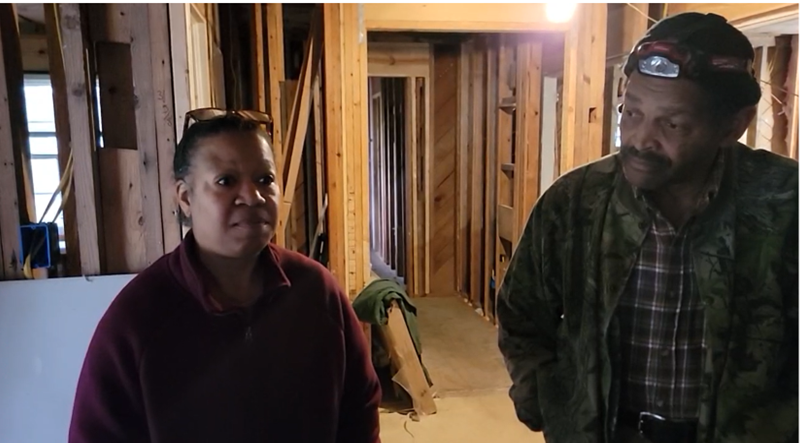
Sonya Black and her family live in an RV behind their house. They boil water for cooking and bathing. Their power comes from drop cords connected to a breaker box on a specially installed power pole in their backyard.
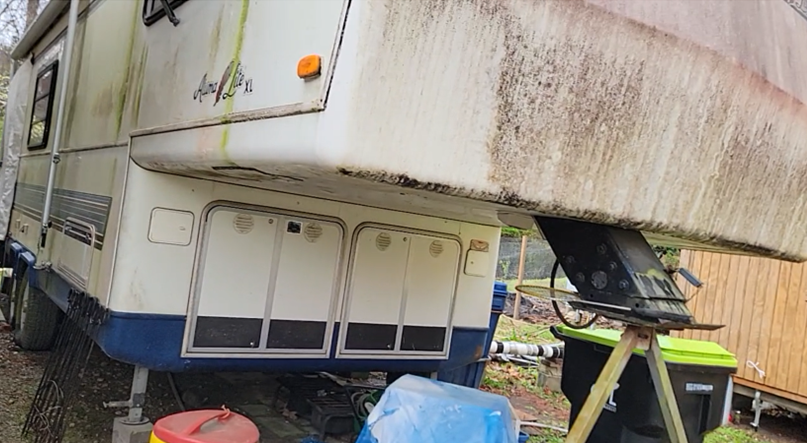
Black and her family of five lived in a hotel for eight months after Hurricane Florence. When that became infeasible financially and logistically, the family moved into an RV that friends donated to them. They have been living there ever since. “We were preparing to go to a homeless shelter because we ran out of money,” she said. “It’s like camping. We’re living out of suitcases.”
“We’re going to see what we can do to get things moving ahead,” Rep. Phil Shepard said as he listened to the Blacks’ experience in the storm and since. “Sometimes it’s just people realizing that people are watching what’s going on.”
The Blacks had evacuated before the storm, but its evidence was abundant. Sonya said, “We came back two weeks later, and everything had already mildewed and molded over.”
Sonya and her husband together described the damage from the storm. “It rained hard for a complete week,” she said. “The shingles never blew off, but the rain went under the shingles, saturated everything inside.”
“It never broke the shingles; they laid back down,” her husband James added. “There was no physical or visual damage you could see to the roof.”
“Then the ceilings fell,” Sonya continued. “Ceilings fell in the sewing/craft room, the living room, and the kitchen. The den had gotten wet from where the water had permeated through, and it flooded five feet in the basement. The sump pump went out because the power went out. “
They tore down walls themselves and hired a rapid-response disaster company to dry out the home.
A contractor they hired to do repairs took the money and left the house unfinished. The Blacks learned that the contractors were fraudulent, but they ultimately decided not to sue. Instead, Sonya and James started a GoFundMe page to replace the insulation and the floors in their home and simultaneously applied to the ReBuild NC program. Once approved, they were told they had to stop working on their home. Now, almost three years later, they are still waiting for their repair work to go to bid.
The (now) six members of the family are doing what they can to manage until work begins on their home and they are eligible for Temporary Relocation Assistance. Two sons live with Sonya and James in the RV, and one of them took a job at Chick-fil-A to help with finances. Their daughter and grandson are living in Virginia because there’s no room in the RV. Sonya is operating her soap-making business out of a shed on their property. “It’s half the size of the basement I used to work in,” she said. “Plus, I lost the room in the house I used as a store.”
Sonya is clearly exasperated. “There needs to be better organization when it comes to ReBuild NC,” she said. “We kept calling, and we would only get ‘waiting on approval.’ Give me something better than that. What are you waiting on? It’s things like that that have us frustrated and have lost trust because we’re a family of six doing everything that we can, and it’s hard.”
She added: “I’m ready for it to be over. All we’re waiting on is sheetrock. Why is it taking so long? They have floors and materials from their GoFundMe, all we need is help to make it happen.”
“There needs to be better organization
when it comes to Rebuild NC”
Sonya Black